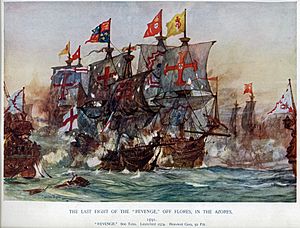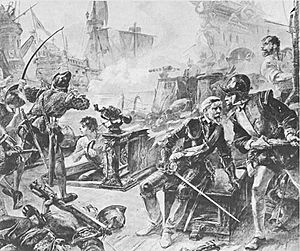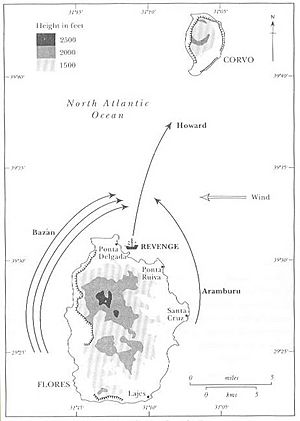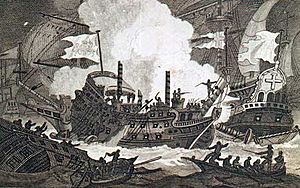Battle of Flores (1591) facts for kids
Quick facts for kids Battle of Flores |
|||||||
|---|---|---|---|---|---|---|---|
| Part of the Anglo–Spanish War | |||||||
 Revenge in action against the Spanish fleet 31 August – 1 September 1591 (Charles Dixon) |
|||||||
|
|||||||
| Belligerents | |||||||
| Commanders and leaders | |||||||
| Alonso de Bazán Martín de Bertendona Marcos de Aramburu |
Earl of Suffolk Richard Grenville † |
||||||
| Strength | |||||||
| 55 warships | 22 warships | ||||||
| Casualties and losses | |||||||
| 2 ships sunk ~100 killed or drowned |
Revenge captured 250 killed or prisoner |
||||||
The Battle of Flores was a big sea battle during the Anglo-Spanish War. It happened near the Island of Flores in 1591.
An English fleet of 22 ships, led by Lord Thomas Howard, was trying to capture Spanish treasure ships. But then, a much larger Spanish fleet of 55 ships, led by Alonso de Bazán, showed up.
Lord Howard ordered his ships to escape. All of them got away except for one brave ship, the Revenge. It was commanded by Admiral Sir Richard Grenville.
Sir Richard Grenville chose to fight the huge Spanish fleet alone. He wanted to protect the other English ships as they escaped. The Revenge fought for a whole day and night. It damaged many Spanish ships. Even though the Revenge was attacked many times, its crew fought bravely.
Finally, Sir Richard Grenville was badly hurt. His remaining crew had to surrender. This battle became famous for the bravery of the Revenge and its crew. A famous poet, Alfred, Lord Tennyson, even wrote a poem about it called The Revenge: a Ballad of the Fleet.
Why the Battle Happened
After Spain's big Armada was defeated in 1588, England wanted to stop Spain from getting stronger. Sir John Hawkins suggested a plan. He wanted to block the flow of treasure from Spain's colonies in the Americas. English ships would patrol the seas to stop Spanish treasure ships.
The Revenge, commanded by Sir Richard Grenville, was part of this patrol in the summer of 1591. Meanwhile, Spain sent a large fleet of about 55 ships. This fleet was led by Alonso de Bazán. He also had Generals Martín de Bertendona and Marcos de Aramburu with him.
Bazán found out that the English ships were patrolling near the northern Azores islands. In late August 1591, the Spanish fleet met up with 8 Portuguese ships. Then, they found the English fleet. The English ships were busy with repairs. Many of their sailors were sick with fever and resting on shore.
The Battle Begins
Bazán wanted to surprise the English ships while they were anchored. But one of his lead ships had a problem, which delayed the attack. It wasn't until 5 PM that Bazán's ships sailed into the channel between Flores and Corvo islands.
Lord Howard, the English commander, knew the Spanish were coming. He quickly managed to get his fleet out to sea. There was some gunfire between the two fleets, but then they separated. However, Sir Richard Grenville chose to fight. He sailed his ship, the Revenge, directly towards the approaching Spanish ships.
Howard's flagship, the Defiance, was hit hard by a Spanish ship before it left the battle. The Revenge was left behind. It was immediately attacked by a Spanish ship called San Felipe. The San Felipe tried to board the Revenge. But its grappling hook broke, and only a few Spanish soldiers made it onto the English ship.
Soon after, another Spanish ship, the San Bernabé, successfully boarded the Revenge. This was a big problem for the Revenge. It lost the advantage of its powerful long-range cannons. The Spanish soldiers fired their muskets heavily. This forced the English gunners to leave their cannons to fight them off.
As night fell, most of the English fleet had escaped. The Spanish ship San Cristobal rammed the Revenge. It put more Spanish soldiers onto the English ship. These soldiers even managed to capture the Revenge's flag. But the English crew fought back fiercely, forcing them to retreat.
The San Cristobal's front was badly damaged from ramming. Other Spanish ships joined the attack. The Revenge was now being attacked by five ships. It was still held by the San Bernabé and the damaged San Cristobal. Grenville and his crew fought bravely with cannons and muskets.
But Sir Richard Grenville was severely wounded. The Revenge was badly damaged, with its masts broken. About 150 of its crew were killed or too hurt to fight. Finally, the Revenge surrendered. During the night, two of the Spanish ships that attacked the Revenge sank after crashing into each other.
What Happened Next
Even though the Revenge had caused a lot of damage, the Spanish treated the surviving English sailors with respect. Sir Richard Grenville was taken to Bazán's flagship. He died two days later from his wounds.
Soon after, the Spanish treasure fleet met up with Bazán's fleet. The combined fleet then sailed towards Spain. But they were caught in a terrible storm that lasted a week. During this storm, the Revenge sank. Fifteen Spanish warships and merchant ships were also lost. The Revenge sank near the island of Terceira. It went down with 70 people on board, including Spanish prize-crew and English prisoners.
This battle showed that Spain's navy was getting strong again. It also proved that it was very hard for the English to capture a well-protected Spanish treasure fleet. The bravery of the Revenge and its crew became a famous story in English history.
See also
 In Spanish: Batalla de Flores (1591) para niños
In Spanish: Batalla de Flores (1591) para niños




